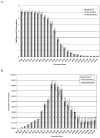Is talk "cheap"? An initial investigation of the equivalence of alcohol purchase task performance for hypothetical and actual rewards
- PMID: 22017303
- PMCID: PMC3266442
- DOI: 10.1111/j.1530-0277.2011.01656.x
Is talk "cheap"? An initial investigation of the equivalence of alcohol purchase task performance for hypothetical and actual rewards
Abstract
Background: Behavioral economic alcohol purchase tasks (APTs) are self-report measures of alcohol demand that assess estimated consumption at escalating levels of price. However, the relationship between estimated performance for hypothetical outcomes and choices for actual outcomes has not been determined. The present study examined both the correspondence between choices for hypothetical and actual outcomes, and the correspondence between estimated alcohol consumption and actual drinking behavior. A collateral goal of the study was to examine the effects of alcohol cues on APT performance.
Methods: Forty-one heavy-drinking adults (56% men) participated in a human laboratory protocol comprising APTs for hypothetical and actual alcohol and money, an alcohol cue reactivity paradigm, an alcohol self-administration period, and a recovery period.
Results: Pearson correlations revealed very high correspondence between APT performance for hypothetical and actual alcohol (ps < 0.001). Estimated consumption on the APT was similarly strongly associated with actual consumption during the self-administration period (r = 0.87, p < 0.001). Exposure to alcohol cues significantly increased subjective craving and arousal and had a trend-level effect on intensity of demand, in spite of notable ceiling effects. Associations among motivational indices were highly variable, suggesting multidimensionality.
Conclusions: These results suggest there may be close correspondence both between value preferences for hypothetical alcohol and actual alcohol, and between estimated consumption and actual consumption. Methodological considerations and priorities for future studies are discussed.
Copyright © 2011 by the Research Society on Alcoholism.
Figures



Similar articles
-
Further evidence of close correspondence for alcohol demand decision making for hypothetical and incentivized rewards.Behav Processes. 2015 Apr;113:187-91. doi: 10.1016/j.beproc.2015.02.012. Epub 2015 Feb 21. Behav Processes. 2015. PMID: 25712039 Free PMC article.
-
Behavioral economic analysis of cue-elicited craving for alcohol.Addiction. 2010 Sep;105(9):1599-607. doi: 10.1111/j.1360-0443.2010.03004.x. Epub 2010 Jul 12. Addiction. 2010. PMID: 20626376 Free PMC article.
-
Time constraints in the alcohol purchase task.Exp Clin Psychopharmacol. 2017 Jun;25(3):186-197. doi: 10.1037/pha0000110. Epub 2017 Feb 27. Exp Clin Psychopharmacol. 2017. PMID: 28240924
-
The Behavioral Economics of Alcohol Demand in French and American University Students.Alcohol Clin Exp Res. 2019 Mar;43(3):531-544. doi: 10.1111/acer.13954. Epub 2019 Feb 7. Alcohol Clin Exp Res. 2019. PMID: 30730582
-
The behavioral economics of alcohol demand in Greek-affiliated college students.Alcohol Clin Exp Res. 2021 Nov;45(11):2322-2334. doi: 10.1111/acer.14704. Epub 2021 Nov 28. Alcohol Clin Exp Res. 2021. PMID: 34839527
Cited by
-
Initial Development of a Brief Behavioral Economic Assessment of Alcohol Demand.Psychol Conscious (Wash D C). 2015 Jun;2(2):144-152. doi: 10.1037/cns0000056. Psychol Conscious (Wash D C). 2015. PMID: 27135038 Free PMC article.
-
Delay discounting for sucrose in alcohol-preferring and nonpreferring rats using a sipper tube within-sessions task.Alcohol Clin Exp Res. 2015 Feb;39(2):232-8. doi: 10.1111/acer.12632. Alcohol Clin Exp Res. 2015. PMID: 25684046 Free PMC article.
-
Intravenous Alcohol Administration Selectively Decreases Rate of Change in Elasticity of Demand in Individuals With Alcohol Use Disorder.Alcohol Clin Exp Res. 2020 Nov;44(11):2336-2342. doi: 10.1111/acer.14460. Epub 2020 Oct 10. Alcohol Clin Exp Res. 2020. PMID: 32945536 Free PMC article.
-
Statistically derived patterns of behavioral economic risk among heavy-drinking college students: A latent profile analysis.Exp Clin Psychopharmacol. 2021 Apr;29(2):191-202. doi: 10.1037/pha0000420. Epub 2020 Jul 30. Exp Clin Psychopharmacol. 2021. PMID: 32730058 Free PMC article.
-
Using Behavior Economics to Understand Alcohol Use Disorders: A Concise Review and Identification of Research Priorities.Curr Addict Rep. 2015 Mar;2(1):68-75. doi: 10.1007/s40429-015-0045-z. Epub 2015 Jan 27. Curr Addict Rep. 2015. PMID: 27795939 Free PMC article.
References
-
- Anton RF, Drobes DJ, Voronin K, Durazo-Avizu R, Moak D. Naltrexone effects on alcohol consumption in a clinical laboratory paradigm: temporal effects of drinking. Psychopharmacology (Berl) 2004;173(1–2):32–40. - PubMed
-
- Bickel WK, Marsch LA, Carroll ME. Deconstructing relative reinforcing efficacy and situating the measures of pharmacological reinforcement with behavioral economics: a theoretical proposal. Psychopharmacology (Berl) 2000;153(1):44–56. - PubMed
-
- Bickel WK, Vuchinich RE. Reframing Health Behavior Change with Behavioral Economics. Lawrence Erlbaum Associates; Mahwah, NJ: 2000.
-
- Bohn MJ, Krahn DD, Staehler BA. Development and initial validation of a measure of drinking urges in abstinent alcoholics. Alcohol Clin Exp Res. 1995;19(3):600–6. - PubMed
Publication types
MeSH terms
Grants and funding
LinkOut - more resources
Full Text Sources
Medical

